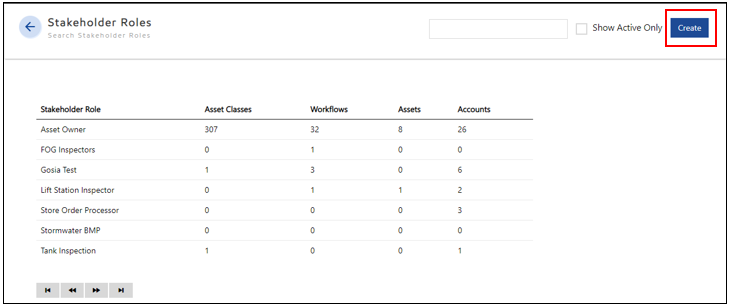Stakeholder roles
Any user can be added as a stakeholder to various objects in Utility Cloud and can be assigned a stakeholder role to indicate their association with that object. Depending on the object you're assigned to as a stakeholder, you'll receive notifications about any activity around that object.
Key Points to Stakeholder Roles
- Stakeholder Roles are user-defined roles that are then associated with specific users and define the user as part of a particular stakeholder group for an account, asset class, asset, workflow, or work schedule. When a user is defined as a stakeholder on the account, asset class, asset, and workflow or work schedule, that user will receive emails, messages, etc. related to that account, asset class, asset, and workflow or work schedule.
- Potential stakeholder roles may be an Owner, Primary Contact.
- To access Stakeholder Roles, select the Stakeholder Roles tile from the Dashboard or from the left navigation menu. By default, only active stakeholders are displayed; the user may select to see the inactive entries by unselecting the ‘Show Active Only’ checkbox.
- The grid lists all Stakeholder Roles that have been created and shows the total number of Accounts, Workflows, Asset Classes, Assets, and Work Schedules associated with the Stakeholder Role.
Create a Stakeholder Role
- Select the Stakeholder Roles tile from the Landing Page or from the left navigation menu.
- Select Create from the Stakeholder Roles screen.
- Enter a Name on the Stakeholder Role Details screen. A new stakeholder role is checked as active by default.
- Select Save.

Security Rights Required: View Stakeholder Roles; Create Stakeholder Roles
Search for a Stakeholder Role
Users can search for Stakeholder Roles by typing a value into the search bar. The engine searches by name or number of Asset Classes, Workflows, Assets, or Accounts.

Security Rights Required: View Stakeholder Roles
Edit a Stakeholder Role
- Select the Stakeholder Roles tile from the Dashboard or from the left navigation menu.
- Select the Stakeholder Role that needs to be changed from the list.
- The user may edit the Name of the Stakeholder role or change the status (Active/Inactive) from the Stakeholder Role Details Screen.
- Select Save.
Security Rights Required: View Stakeholder Roles; Edit Stakeholder Roles
Assigning Stakeholders
Account Stakeholders
Account Stakeholders are users assigned as account representatives.
If a user is defined as an account stakeholder that user's name will display on the Account Details page and users will be able to navigate to their User Details to message them directly regarding any account specific questions.
To assign a Stakeholder at the Account level:
- Select the Account from the list.
- Select the + Add Additional Stakeholders button.
- Select the Stakeholder Role from the 1st dropdown.
- Select the User from the second dropdown.
- Select Save.
Security Rights Required: View Accounts; Edit Accounts
Asset Stakeholders
If a user is defined as an asset stakeholder, that user may receive reports of any edits made to the asset. If there are reports configured to send to asset stakeholders based on a Google report setting the stakeholder will also receive notifications.
To assign a Stakeholder at the Asset level:
- Select the Asset from the search results on the Asset Search.
- Select Edit.
- Select the + Add Additional Stakeholders button.
- Select the Stakeholder Role from the 1st dropdown.
- Select the User from the second dropdown.
- Save Save on the Asset Edit screen.
Security Rights Required: View Assets; Edit Assets
Asset Class Stakeholders
When a user is defined as a stakeholder in the asset class, if any assets are added or edited for that assets class, the user will be notified based on the asset class notification preferences selected:
- Send notification email when an asset is created.
- Send notification email when an asset is deactivated or reactivated.
- Send notification email when an asset is edited.
If there are reports configured to send to asset class stakeholders based on a Google report setting the stakeholder will also receive notifications.
To assign a Stakeholder at the Asset Class level:
- Select the Asset Class from the search results on the Asset Class Search.
- In the Stakeholders section of the main Edit modal, select the Edit pencil icon.
- Check the relevant Stakeholder Role, then add the relevant user to the Users section.
- Select Ok to save the Stakeholders selections, then select Ok to save edits.
- Select Save on the Asset Class Builder screen.
Security Rights Required: View Asset Classes; Save Asset Classes
Workflow Stakeholders
When a user is defined as a stakeholder on a particular workflow, that user will be notified when the workflow is completed based on the setting "Notify Stakeholders".If there are reports configured to send to workflow stakeholders based on a Google report setting the stakeholder will also receive notifications.
To assign a Stakeholder at the Workflow level:
- Select the Workflow from the search results on the Workflow Class Search.
- In the Stakeholders section of the main Edit modal, select the Edit pencil icon.
- Check the relevant Stakeholder Role, then add the relevant user to the Users section.
- Select Ok to save the Stakeholders selections, then select Ok to save edits.
- Select Save on the Workflow Class Builder page.
Security Rights Required: View Workflows; Save Workflows
Work Schedule Stakeholders
To assign a Stakeholder at the Work Schedule level:
- Select the Work Schedule from the appropriate account on the Work Scheduler page.
- In the Stakeholders section, select the + Add Additional Stakeholders button.
- Select the Stakeholder Role from the first dropdown.
- Select the User from the dropdown.
- Select Save on the Work Schedule Editor screen.
Security Rights Required: View Work Scheduler
